|
Kolar and Chikaballapur districts are located in the south eastern part of Karnataka State, between 12o44’N to 13o45’N latitude and 77o12’E to 78o35’E longitude (Figure 2.1). Spatial extent of is 8213 sq.km (Chikaballapur: 4244 sq.km, Kolar: 3969 sq.km). Kolar and Chikballapur districts are located in the semi arid climatic zone, with average rainfall of 690 ± 201 mm/yr, temperature between 14.4oC (January) to 35.7oC (April). Terrain Topography varies between 595 m to 1474 m above Mean Sea Level (Figure 2.2). Slope is gentle across the plains and steep across the hill ranges. Kolar and Chikballapur together had over 4800 lakes (SOI 1:50000 topographic sheets 1970’s) encompassing an area of 45085 hectares with current water holding capacity of ~15 TMC (with silt accumulation). Population has increased from 24,45,586 (2001 census) to 28,21,506 (2011 census) at a decadal rate of 15.3%. Population at the year 2021 is projected to be 32,53,196 persons (Figure 2.3). Considering domestic demand is about 135 lpcd, annual demand by 2021 would be ~5.27 TMC (~150 Million cubic meters).
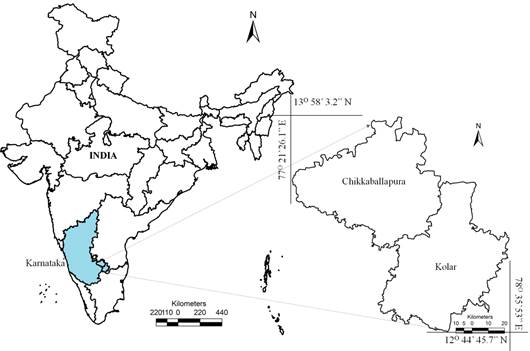
Figure 2.1: Study Area (Kolar and Chikballapur districts, Karnataka)
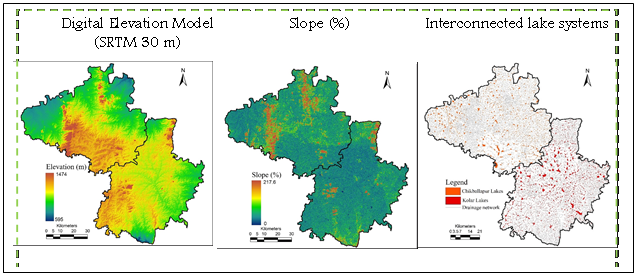
Figure 2.2: Terrain topography and water bodies in Kolar (Kolar and Chikballapur districts)
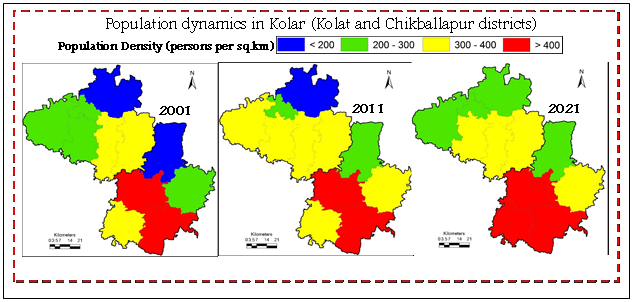
Figure 2.3: Population Dynamics in Kolar and Chikballapur districts
2.1 DATA: Data required for hydrological and spatial analyses were compiled from multiple agencies. Table 2.1 describes the various data used for assessment of the hydrological regime across the catchments. Data used include satellite remote sensing data acquired through Landsat 8 series of 2016. Rainfall data was acquired from Bureau of Economics and Statistics, Karnataka, Temperature data was sourced from worldclim of 1km resolution. Census data from government of India, state and district census departments. This data was supplemented with secondary data from various sources as tabulated in table 2.1. Data inventory was also done through field investigations and feedback from public.
Table 2.1: Data used for land use and assessment of hydrologic regime
Data |
Source |
Description |
Remote sensing data – spatial data |
Landsat 8 Satellite, 2016 from USGS earth explorer (http://landsat.usgs.gov, http:// glcf.umd.edu/data/landsat/, http:// landsat.gsfc.nasa.gov/, http:// www.landsat.org/ |
Remote sensing data of 30m spatial resolution and 16 bit radiometric resolution were used to analyse the land use at catchment level |
Rainfall |
Rain gauge station wise – compiled from Directorate of Economics and Statistics – Karnataka (http://des.kar.nic.in/), India Meteorological Department (IMD), Pune (http://imdpune.gov.in). |
Daily rainfall data for 110 year between 1901 and 2015. Used to assess the rainfall distribution over the basin |
Crop Calendar |
Agriculture Department of Karnataka, (http://raitamitra.kar.nic.in/), iKisan (http:// www.ikisan.com), National Food Security Mission (http://www.nfsm.gov.in/. |
To understand when, where and which crops are grown which helps in understanding the crop water requirement based on the growth phases |
Crop Coefficient |
Food and Agriculture Organization- FAO (http://www.fao.org), Agriculture Department of Karnataka (http:// http://raitamitra.kar.nic.in/KAN/index.asp). |
Each land use has its own evaporative coefficients, used to estimate the Actual Evapotranspiration. |
Temperature (max, min, mean), Extra-terrestrial solar radiation |
Worldclim (http://www.worldclim.org/), FAO (http://www.fao.org), http://www.cru.uea.ac.uk, http:// climate.nasa.gov/, http:// data.giss.nasa.gov/gistemp/ |
Temperature data of 1km spatial resolution, available for each month. Extra-terrestrial solar radiation, every 10 North latitude available across different hemispheres for various months. Used to estimate the Potential Evapotranspiration |
Population Census |
Census India (http://censusindia. gov.in) 1991, 2001 and 2011 |
Data available at village level, used to estimate the population for the year 2021, and estimate the water requirement for domestic use at sub basin level |
Livestock Census |
Kolar district at a glance 2010-2016 (http://www.kolar.nic.in) |
Taluk level data was used to estimate the livestock population and estimate water requirement at each of the river basins. |
Digital Elevation data |
Cartosat DEM from NRSC-Bhuvan (http://bhuvan.nrsc.gov.in) |
Carto-DEM of 30m resolution. Used to derive the catchment boundaries, stream networks in association with Google earth and Toposheets |
Secondary Data |
Google Earth (http://earth. google.com), Bhuvan (http://bhuvan.nrsc.gov.in), French Institute Maps (http://www.ifpindia.org/.), Western Ghats biodiversity portal (http:// thewesternghats.indiabiodiversity.org/), the Survey of India topographic maps (http://www.surveyofindia.gov.in/) |
Supporting data in order to assist land use classification, delineation of streams/rivers/ Catchment, Geometric correction |
Field data |
GPS based field data, data form public (stratified random sampling of households) |
Geometric Corrections, Land use classification, Crop water requirement, livestock water requirement estimate |
2.2 METHOD: The method involved in evaluation of the hydrological status is as depicted in figure 2.4 and figure 2.5. Hydrologic assessment in the catchment involved 1) delineation of catchment boundary 2) land use analysis, 3) assessment of the hydro meteorological data, 4) analysis of population census data, 5) compilation of data through public interactions for assessing the water needs for livestock, agriculture/horticulture and cropping pattern, and 6) evaluation of hydrologic regime.

Figure 2.4: Protocol followed for hydrologic assessment
2.3 Delineation of catchment boundary: Catchment boundaries and the stream networks (Figure 1.1) considering the topography of the terrain based on CartoSat DEM were delineated using the hydrologic modeling tool in GRASS GIS. These catchment boundaries were overlaid on the extracted boundaries from the Survey of India topographic maps in order to check and correct the variations (if any due to errors in DEM), Corrected catchment boundaries were further overlaid on Google earth in order to visualize the terrain variations.
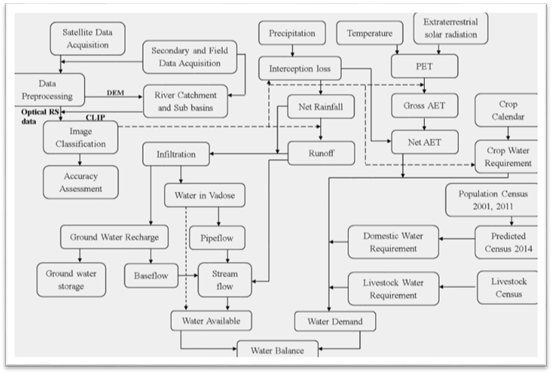
Figure 2.5: Component wise details of the method
2.4 Land use Assessment: Land use refers to heterogeneous terrain with the interacting ecosystems in the landscape and is characterized by its dynamics, which are governed by human activities and natural processes. Human induced land use and land cover (LULC) changes have been the major driver of the landscape dynamics at local levels. Land use assessment was carried using the maximum likelihood classification technique. Understanding of landscape dynamics helps in the sustainable management of natural resources.
Land use analysis involved i) generation of False Colour Composite (FCC) of remote sensing data (bands – green, red and NIR). This helped in locating heterogeneous patches in the landscape ii) selection of training polygons (these correspond to heterogeneous patches in FCC) covering 15% of the study area and uniformly distributed over the entire study area, iii) loading these training polygons co-ordinates into pre-calibrated GPS, vi) collection of the corresponding attribute data (land use types) for these polygons from the field. GPS helped in locating respective training polygons in the field, iv) supplementing this information with Google Earth v) 65% of the training data has been used for classification, while the balance is used for validation or accuracy assessment. The process of assessing land use is as follows:
2.4.1 Satellite data acquisition: Satellite data sets for the whole world (earth) at different resolutions are available since 1972 (Landsat1) up to date. For the land use analysis, Landsat 8 (2013) data was obtained from the public domain (USGS: http://earthexplorer.usgs.gov/). Survey of India (SOI) topo-sheets of 1:50000 and 1:250000 scales were used to generate base layers of catchment boundary, stream network, etc.
2.4.2 Data pre-processing: The remote sensing data obtained were geo-referenced, rectified and cropped pertaining to the study area. Geo-registration of remote sensing data (Landsat data) has been done using ground control points collected from the field using pre calibrated GPS (Global Positioning System) and also from known points (such as road intersections, etc.) collected from geo-referenced topographic maps published by the Survey of India and from online BHUVAN portal (http://bhuvan.nrsc.gov.in).
3.0 Preparation of False Colour Composite: False colour composite is the representation of earth features in their non-original colours in order to identify the heterogeneity in various landscapes. FCC is prepared by combination of spectral bands NIR, GREEN and RED bands. Figure 2.4 depicts FCC of the catchments. |
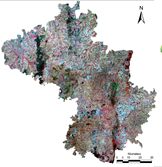
|
Figure 2.4: False Color Composite (FCC) – Kolar and Chikballapur districts |
2.4.2 Preparation of signature data set: Signatures are the training datasets (training polygons) which are used to classify the satellite image into various land use classes based. Signatures were developed for various land use categories based on the site knowledge [Field data, Topographic maps (the Survey of India: http://surveyofindia.gov.in), Google earth (http://www.googleearth.com), Bhuvan (http://bhuvan.nrsc.gov.in), Western Ghats Biodiversity Portal (thewesternghats.indiabiodiversity.org/), French institute vegetation, geoclimate and soil maps (www.ifpindia.org/.../data-paper-–-high-resolution-vegetation-cover-data-southern-western-ghats-india)] and based on spectral properties of landscape elements (Figure 2.5). Training data collected spread uniformly across the study area covering at least 15% of the total area.
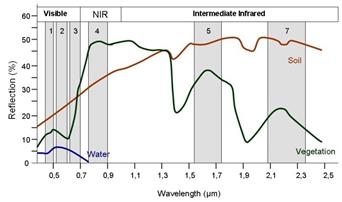
|
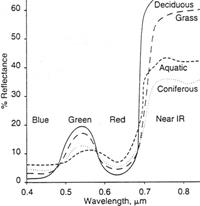
|
Source: www.seos-project.eu |
Source: http://www.geog.ucsb.edu |
Figure 2.5: Spectral properties of diverse landscape elements
2.4.4 Classification of Satellite image: Land use analysis was carried out using supervised pattern classifier - Gaussian maximum likelihood algorithm. The classifier computes the mean and variance of digital numbers under each training data set, based on which unknown pixel is categorized under a land use class. Recent remote sensing data (2016) was classified using the collected training samples. Statistical assessment of classifier performance based on the performance of spectral classification considering reference pixels is done which include computation of kappa (κ) statistics and overall (producer's and user's) accuracies. For earlier time data, training polygon along with attribute details were compiled from the historical published topographic maps, vegetation maps, revenue maps, etc. Of the overall signatures, 65% of the total signatures are considered in classification of the image and 35% of the pure signatures are used for assessing the accuracy. Land use was computed using the temporal data through open source program GRASS - Geographic Resource Analysis Support System (http://ces.iisc.ac.in/grass). Land use categories include i) Water bodies (Lakes/tanks, rivers, streams, ii) Built up (buildings, roads or any paved surface, iii) Open Spaces iv) Evergreen forest (Evergreen and Semi Evergreen), v) Deciduous forest (Moist deciduous and dry deciduous) vi) Scrub land and grass land, vii) Agriculture Plantation (coconut, arecanut, rubber) viii) Forest plantations (Acacia, etc.)
2.4.5 Accuracy assessment: Accuracy is necessary in order to check if the classified remote sensing data agrees with the reference data. The reference data is based on the field data, or collateral data. Kappa is estimated as a measure of agreement between the reference map and the classified map.
2.5 Assessment of the hydro meteorological data: The method involved assessment of the rainfall data obtained from various sources such as TRMM (http://trmm.gsfc.nasa.gov/), data from local rain gauge stations (http://des.kar.nic.in) in and around the study site. Long term precipitation data helped in understanding the rainfall variability over decades. Iso-lines across the months were developed based on the spatial rainfall variation of rainfall w.r.t the rain gauge stations across the basin. Along with rainfall, temperature (minimum, maximum and average), extra-terrestrial solar radiation across the catchment were used to hydrological behaviors of the catchments which enables to understand the hydrological status.
2.5.1 Rainfall: Point based daily rainfall data from various rain gauge stations in and around the study area between 1901 and 2015 were considered for analysis of rainfall. The rainfall data used for the study were obtained from
- Directorate of economics and statistics, Government of Karnataka (http://des.kar.nic.in)
- Indian metrological data (IMD), Government of India (http://imdpune.gov.in)
- Tropical rainfall Measuring Mission (TRMM), NASA (http://trmm.gsfc.nasa.gov/),
Some rain gauge stations had incomplete records with missing data for few months. Missing data’s were computed based on neighboring stations and also through regression analysis. Rainfall trend analysis was done for select rain gauge stations to assess the variability of rainfall at different locations in the study area.
Long term daily rainfall data were used to compute the monthly and annual rainfall in each rain gauge station based on mean and standard deviation of select rain gauge stations in the study region. The average monthly and annual rainfall data were used to derive rainfall throughout the study area through the process of interpolation (isohyets). The interpolated rainfall data was used to derive the gross yield (RG) in the basin (given in equation 1). Net yield (RN) was quantified (equation 2) as the difference between gross rainfall and interception (In).
RG = A * P …….(1)
RN = RG – In ……(2)
Where
RG : Gross rainfall yield volume,
A: Area in Hectares, P: Precipitation in mm,
RN: Net rainfall yield volume
In: Interception volume
2.5.2 Runoff: This is the portion of rainfall that flows in the streams after precipitation. Runoff can be typically divided into two categories 1) Surface runoff or direct runoff 2) sub surface runoff
Surface runoff: Portion of water that directly enters into the streams during rainfall, which is estimated based on the empirical equation 3.
Q = Σ(Ci*PR*Ai) ……(3)
Where Q: Runoff in cubic meters per month
C: Runoff Coefficient which is dependent upon various land uses (listed in table 2.2 based on land use type)
PR: Net rainfall in mm ( Gross rainfall – Interception)
i: Land use type
Table 2.2: Runoff Coefficients
Land Use |
Run-off Coefficient |
Urban |
0.85 |
Agriculture |
0.6 |
Open lands |
0.7 |
Evergreen forest |
0.15 |
Scrub/Grassland |
0.6 |
Forest Planation |
0.65 |
Agriculture Plantation |
0.5 |
Deciduous Forest |
0.15 |
2.5.3 Interception: During monsoons, portion of rainfall does not reach the surface of the earth, it remains on the canopy of trees, roof tops, etc. and gets evaporated. Field studies in Western Ghats show that, losses due to interception is about 15% to 30%, based on the land use. Table 2.3 shows the interception loss across various rainy months and land uses.
Table 2.3: Interception loss
Vegetation types |
Period |
Interception |
Evergreen/semi evergreen forests |
June-October |
I = 5.5 + 0.3 (P) |
Moist deciduous forests |
June-October |
I = 5 + 0.3 (P) |
Plantations |
June-October |
I = 5 + 0.2 (P) |
Agricultural crops (paddy)
|
June |
0 |
July-August |
I = 1.8+ 0.1 (P) |
September |
I = 2 + .18 (P) |
October |
0 |
Grasslands and scrubs |
June-September |
I = 3.5 +0.18 (P) |
October |
I = 2.5 + 0.1 (P) |
2.5.4 Infiltration: Due to precipitation, the portion of water enters the subsurface of the earth (vadoze and groundwater zones). Only after saturation of sub surfaces, overland flow is noticed in streams. The water stored in sub-surfaces will flow laterally towards streams and contributes to stream flow during non-monsoon periods, which are referred as pipe flow (during post monsoon) and base flow (during summer).
Inf = RN – Q ……(4)
2.5.5 Ground water recharge: This is the portion of water that is percolated below the soil stratum (vadose) after soil gets saturated. Recharge is considered the fraction of infiltrated water that recharges the aquifer after satisfying available water capacity and pipe flow. Equation 5 (Krishna Rao equation, 1970) was used to determine the ground water recharge.
GWR = RC * (PR – C) * A ……(5)
Where
GWR : Ground water recharge
RC : Ground water recharge coefficient (listed in table 2.4)
C : Rainfall Coefficient
A : Area of the catchment
The recharge coefficient and the constant vary from location to location based on the annual rainfall.
Table 2.4: Ground water recharge coefficients
Annual Rainfall |
RC |
C |
400 to 600mm |
0.20 |
400 |
600 to 1000 mm |
0.25 |
400 |
> 2000 mm |
0.35 |
600 |
2.5.6 Subsurface Flow (Pipe flow): Part of the infiltrated effective rainfall circulates more or less horizontally (lateral flow) in the superior soil layer and appears at the surface through stream channels is referred as subsurface flow. The presence of a relatively impermeable shallow layer favours this flow. Subsurface flows in water bearing formations have a drainage capacity slower than superficial flows, but faster than groundwater flows. Pipe flow is considered to be the fraction of water that remains after infiltrated water satisfies the available water capacities under each soil. Pipe flow is estimated for all the basins as function of infiltration, ground water recharge and pipe flow coefficient, given by equation 6
PF = (Inf – GWR) * KP …….(6)
Where
PF : Pipeflow
Inf : Infiltration volume
KP : Pipe flow coefficient
2.5.7 Groundwater Discharge: Groundwater discharge or base flow is estimated by multiplying the average specific yield of aquifer under each land use with the recharged water. Specific yield represents the water yielded from water bearing material. In other words, it is the ratio of the volume of water that the material, after being saturated, will yield by gravity to its own volume. Base flow appears after monsoon and pipeflow has receded. This water generally sustains flow in the rivers during the dry season.
GWD = GWR * YS …… (7)
Where
GWD = Ground water discharge
GWR = Ground water recharge
YS = Specific yield
2.6 Estimation of Water Demand
2.6.1 Evapotranspiration: Evaporation is a process where in water is transferred to atmosphere as vapour. Transpiration is the process by which water is released to the atmosphere from plants through leaves and other parts above ground. In the process of transpiration water is taken into the atmosphere from ground (soil) through the roots. On the other hand, evaporation continues throughout the day and night at different rates. The process of evaporation takes place on all different land uses. Evapotranspiration is the total water lost from different land use due to evaporation from soil, water and transpiration by vegetation. Some of the important factors that affect the rate of evapotranspiration are: (i) temperature, (ii) wind, (iii) light intensity, (iv) sunlight hours, (v) humidity, (vi) plant characteristics, (vii) land use type and (viii) soil moisture. If sufficient moisture is available to completely meet the needs of vegetation in the catchment, the resulting evapotranspiration is termed as potential evapotranspiration (PET). The real evapotranspiration occurring in specific situation is called as actual evapotranspiration (AET). These evapotranspiration rates from forests are more difficult to describe and estimate than for other vegetation types.
Potential evapotranspiration (PET) is determined using Hargreaves method (Hargreaves, 1972) an empirical based radiation based equation, which is shown to perform well in humid climates. PET is estimated as mm using the Hargreaves equation is given by equation 8.
PET = 0.0023 * (RA/λ) *  * *  …… (8) …… (8)
Where
RA = Extra-terrestrial radiation (MJ/m2/day) (FAO)
Tmax = Maximum temperature
Tmin = Minimum temperature
λ = latent heat of vapourisation of water (2.501 MJ/kg)
Actual evapotranspiration is estimated as a product of Potential evapotranspiration (PET) and Evapotranspiration coefficient (KC) (table 2.5), given in equation 9. The evapotranspiration coefficient is a function of land use varies with respect to different land use. Table 2.5 gives the evapotranspiration coefficients for different land use
AET = PET * KC ……(9)
Table 2.5: Evapotranspiration coefficient
Land use |
KC |
Built-up |
0.15 |
Water |
1.05 |
Open space |
0.3 |
Evergreen forest |
0.95 |
Scrub and grassland |
0.8 |
Forest Plantation |
0.85 |
Agriculture Plantation |
0.8 |
Deciduous forest |
0.85 |
Note: the crop water requirement was estimated for different crops and different seasons based on land use, assumption is individual crop water requirement and different growth phases (need different quantum of water for their development inclusive of evaporation).
2.6.2 Domestic water demand: Understanding the population dynamics in a region is necessary to quantify and also to predict the domestic water demand. Population census for villages during 2001 and 2011 were considered in order to compute the population of the basin level. Based on the rate of change of population (equation 10), the population for the year 2014 was predicted as given in equation 11.
r = (P2011/P2001 – 1)/n ……(10)
Where
P2001 and P2011 are population for the year 2001 and 2011 respectively
n is the number of decades which is equal to 1; r is the rate of change
P2021 = P2021 * (1 + n*r) ……(11)
Where
P2021 is the population for the year 2021; n is the number of decades
Domestic water demand is assessed as the function of water requirement per person per day, population and season. Water required per person include water required for bathing, washing, drinking and other basic needs. Water requirements across various seasons are as depicted in table 2.6.
Table 2.6: Seasonal water requirement
Season |
Water lpcd |
Summer |
150 |
Monsoon |
125 |
Winter |
135 |
2.6.3 Livestock water requirement: Household surveys were conducted with the structured questionnaires to understand the agricultural cropping pattern and water needed for various crops in the catchment. Livestock population details were obtained from the district statistics office and water requirement for different animals were quantified based on the interviews. Table 2.7 gives the water requirement for various animals.
Table 2.7: Livestock water requirement
|
Water Requirement in Liters per animal |
Season\Animal |
Cattle |
Buffalo |
Sheep |
Goat |
Pigs |
Rabbits |
Dogs |
Poultry |
Summer |
100 |
105 |
20 |
22 |
30 |
2 |
10 |
0.35 |
Monsoon |
70 |
75 |
15 |
15 |
20 |
1 |
6 |
0.25 |
Winter |
85 |
90 |
18 |
20 |
25 |
1.5 |
8 |
0.3 |
2.6.4 Crop water requirement: The crop water requirement for various crops was estimated considering their growth phase and details of the cropping pattern in the catchment (based on the data compiled from household surveys and publications such as the district at a glance, department of agriculture). Land use information was used in order to estimate the cropping area under various crops. Figure 2.8 provides the information of various crop water requirements based on their growth phase as cubic meter per hectare.
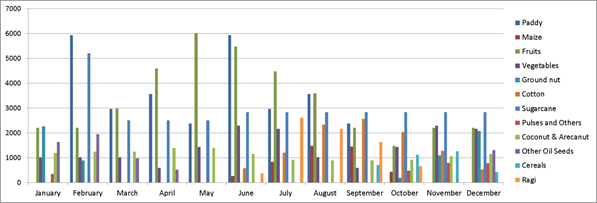
Figure 2.8: Crop water requirement (as cum per hectare per month)
2.7 Evaluating Hydrological Status: The hydrological status in the catchment is analysed for each month based on the water balance which take into account the water available to that of the demand. The water available in the catchment is function of water in the soil, run off (streams and river) and water available in the water bodies (Lentic water bodies such as lakes, etc.). Water demand in the catchment is estimated as the function of crop water demand, domestic and livestock demand and the evapotranspiration. The catchment is considered hydrological sufficient, if the water available caters the water demand completely else the deficit catchment, if the water demand is more than the water available in the system.
|